33 Keys to Decoding the Korean Wave #21 K-Golf : Queens of the Greens, Goddess of Golf
33 Keys to Decoding the Korean Wave #21 K-Golf
#21 Queens of the Greens, Goddess of Golf
*한류를 이해하는 33가지 코드 #21 그린의 여왕들, 골프의 여신들 <Korean version>
https://www.nyculturebeat.com/index.php?mid=Focus&document_srl=4082766
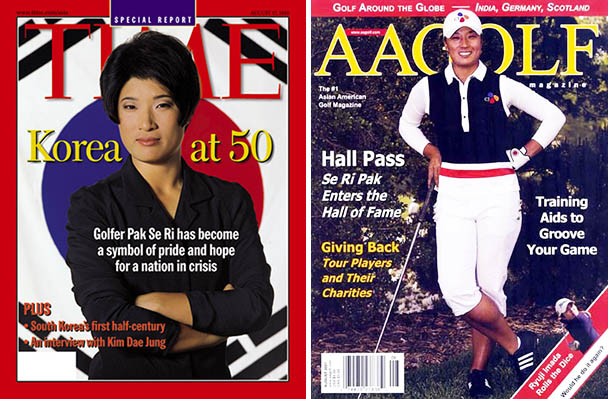
Se Ri Pak appeared on the cover of the weekly “Time” magazine in 1998 (left) / In 2007, she was inducted into the LPGA Hall of Fame and graced the cover of “Asian American Golf” magazine.
-South Korean women have golf down to a tee <Telegraph, 2019>
-K-golf: South Korea’s female golfing phenomenon <BBC, 2017>
-South Korea’s golfing women: “You’re either a champion, or nothing” <CNN, 2016>
-South Korean queens of greens rule women’s golf <AFP>
-Why Korea Makes The World’s Best Women Golfers <Wall Street Journal, 2007>
-South Korea Becomes New Face of L.P.G.A. <New York Times, 2006>
In 1998, 20-year-old Se Ri Pak was crowned the “Queen of Golf” by winning four tournaments in the season, including the US Women’s Open and LPGA Championship. And, over the past 20 years, world women’s golf has been dominated by Se Ri’s Kids, descendants of Se Ri Pak.
Se Ri Pak is a legend in Korean golf. She was a national hero who gave hope to the people when Korea was struggling with the financial crisis (IMF). Just four months after her 1998 debut with the LPGA, she won the McDonald’s LPGA Championship and the U.S. Women’s Open Championship. She won the Rookie of the Year title by winning four tournaments her first season, including the Jamie Farr Kroger Classic and Giant Eagle LPGA Classic. Se Ri Pak, who achieved the “barefoot fighting spirit” success story, recorded a total of 25 wins on the LPGA Tour and 39 wins in her career. In 2007, she became the first and youngest Asian player to be inducted into the World Golf Hall of Fame.
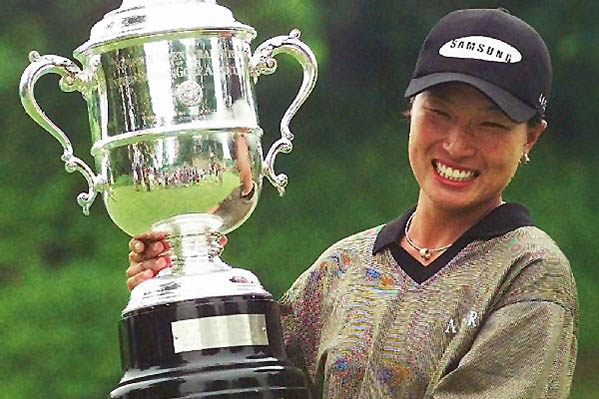
Se Ri Pak won the US Women’s Golf Championship on July 7, 1998. Photo: USGA
The Se Ri Pak craze continued with Mi-Hyun Kim, Grace Park (Ji-eun Park), and Hee-won Han, as well as the "Se Ri Kids" who nurtured their golfing dreams after being inspired by Se Ri Pak's fighting spirit. This group includes Jiyai Shin, Inbee Park, Na Yeon Choi, So Yeon Ryu, Sung-hyun Park, Jin-young Ko, and Jeong-eun Lee6, all of whom have achieved victory at the LPGA or U.S. Women's Open championships. There are many KLPGA members with the same name, including Jeong-eun Lee (6), Min-ji Kim (6), Min-seon Kim (5), and Ji-hyeon Lee (5). Inbee Park, who debuted as a professional in 2012, has won seven major tournaments, including two US Open titles (2008, 2013) and the PGA Championship (2013, 2014, 2015), and won a gold medal at the 2016 Rio Olympics. She achieved the “Golf Gland Slam.” And, she became the youngest person to be inducted into the LPGA Tour Hall of Fame, following Se Ri Pak in 2016.
Koreans continued to achieve success in golf competitions that had slowed down due to the coronavirus pandemic. Minjee Lee (26), a Korean-Australian, won the U.S. Women’s Open held in Pine Needles, North Carolina in June, 2022. Second place was Nina Harigae (USA), third place was Hye-jin Choi (South Korea), fourth place was Jin-young Ko (South Korea) and 5th place went to Korean New Zealander Lydia Ko (Bo-Gyung Ko). There were four Korean players in the top five. Then, later in June 2022, In Gee Chun won the KPMG Women’s PGA Championship, the third major tournament of the LPGA Tour season held in Bethesda, Maryland.
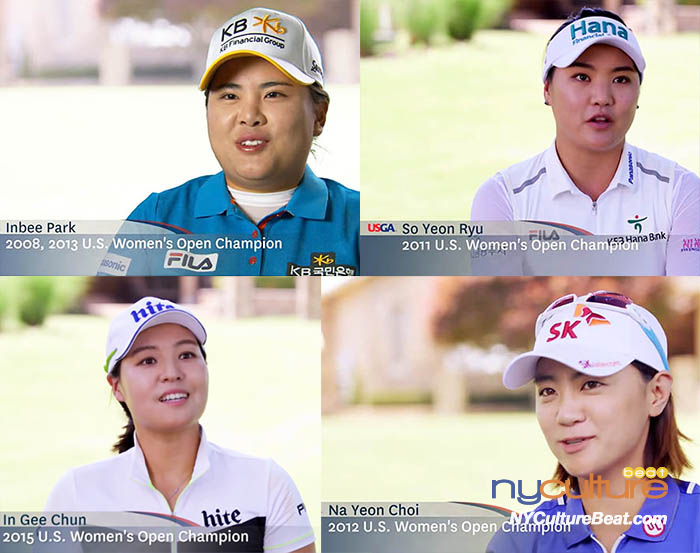
Inbee Park (clockwise from top left), who is said to have been inspired by Pak to become a golfer, So Yeon Ryu, Na Yeon Choi, and In Gee Chun, all became US Open champions. Photo: USGA *Se Ri Pak: Inspiring a Generation, USGA <YouTube>
Since Se Ri Pak became the first Korean to win the US Open in 1998, 10 Korean golfers have won the Champion Cup at the US Open until 2019. Birdie Kim (Mi-Hyun Kim, 2005), Inbee Park (2008, 2013), Eun-hee Ji (2009), Na Yeon Choi (2012), Michelle Wie (Seong-mi Wi, 2014), In-gee Chun (2015), Sung-hyun Park (2014, 2017) and Jeong-eun Lee6 (2019) won the championship.
In the early 2000s, a large number of Korean players participated and swept the Champions Cup at the LPGA Women’s Open, so much so that the U.S. media called the U.S. Open the “US Korea Open.” And, in August 2008, the LPGA caused controversy by mandating an English oral evaluation test for players starting in 2009. In 2008, the LPGA Tour had 121 international players, with 45 of them hailing from Korea. It's worth noting that men's golf (PGA) does not enforce mandatory English language regulations. The LPGA's rule, which appeared to be targeted at the increasing number and achievements of Korean female players, faced criticism for being racist and applying a double standard. Consequently, the rule was rescinded after just two weeks.
LPGA Commissioner Carolyn Bivens, who pushed for the mandatory English regulation, was criticized by the U.S. media and other domestic and foreign players, and was forced to resign in disgrace in July 2009, with two years remaining in her term. Bivens was replaced by Michael Whan, who served as LPGA commissioner until May 2021.
U.S. Women’s Open Champions
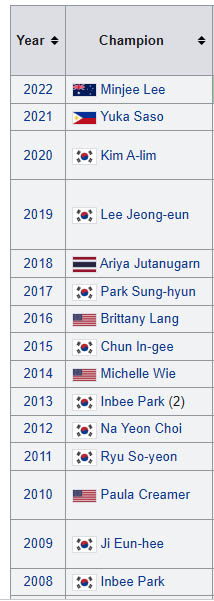
Wikipedia
Seven Secrets to Korea’s Dominance of Women’s Golf
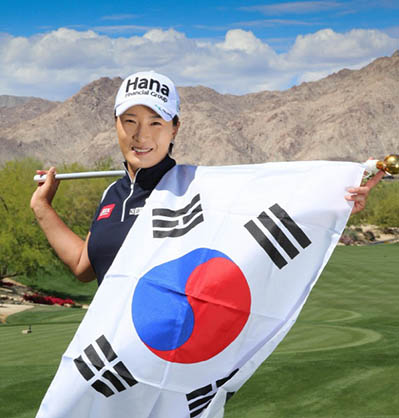
Se Ri Park
The world’s media, including the New York Times, Wall Street Journal, CNN, BBC, Telegraph, and AFP, have shown great interest in the secrets and mysteries of how and why Korean female golfers conquered the world. President Donald Trump, a golf fanatic, is no exception. During his visit to Korea in June 2019, Trump met with Pak Se-ri, head coach of the women’s golf team, at the Blue House Korea-U.S. leaders’ dinner and asked, “Why are American players worse than Korean players?” and reportedly suggested a round of golf with Pak.
In 2019, Ben Harpring of Women’s Golf wrote in “Secrets to South Korea’s Dominance of Women’s Golf”: “So what are the secrets to Korea’s consistently amazing success in women’s golf? There must be something unique that separates a country the size of Indiana geographically, with a population roughly 16% that of the United States, from the rest of the golf world.” Harpring answered: “Firstly, Korea has the best professional golf development program on the planet, and secondly, there were three shining stars (Se Ri Pak, Jiyai Shin, and So Yeon Ryu, who showed young girls across South Korea what was possible.”

“Se-ri Kid” Inbee Park achieved golf’s Gold Grand Slam with seven major wins and a gold medal at the Rio Olympics, and she was inducted into the LPGA Hall of Fame in 2016.
“Empress of Golf”' Annika Sörenstam said about Korean golfers at a press conference during her visit to Korea in 2009, “They are very, very solid. Consistency, great technique and an incredible work ethic are three elements for them to become successful. Other players are learning from Koreans.” In an interview with Financial News Korea in 2015, Inbee Park said, “Compared to other sports, golf is more about mental strength and natural talent than physique requirements. In that respect, Korean players seem to have a strong will and good natural sense.” In addition, the current phenomenon seems to show that parents’ willingness and sacrifice for their children’s education is ahead of that of parents of athletes from other countries.”
#1 Mental 80%
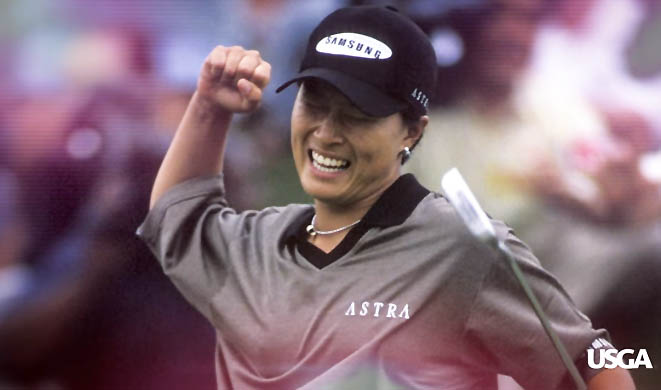
Se Ri Pak’s moment of victory at the 1998 US Women’s Open. Photo: USGA
Jack Nicklaus, an 18-time major championship winner said, “Golf is 80% mental, 10% ability, and 10% luck.”
The mental strength of the Korean people is probably the highest in the world. Over the course of our long history, our people have experienced war, colonial rule, division, dictatorship, and poverty, and have risen to become an economically advanced country today. The driving force is patience, hungry spirit, determination to win, and indomitable fighting spirit. We have fierce grit and perseverance.
Korean women, who have a DNA of perseverance, cultivate their mental strength through self-denial training with the mentality of practicing to death in highly competitive sports. Unlike foreign female players who usually take up golf as a hobby, Korean players show persistence with the goal of succeeding in the professional world. Professional success comes with money. Here, the mental power of persistence, tenacity, courage, guts, composure, concentration, purpose, and calmness is a secret weapon that can withstand even the inferiority of physical strength and adverse conditions. A strong mentality is the tenacity of Koreans that other ethnic groups cannot match.
So Yeon Ryu, who won the 2011 US Women’s Open, said in an interview with Financial News Korea in 2015, “Korean players’ ability to control their emotions is the driving force behind them becoming the best in the world. Koreans have excellent emotional control skills. Even if they get angry, they are good at controlling it,” she said. “Perhaps it is because there is a social atmosphere in which it is impolite to show anger, but Korean players’ ability to control their emotions is different from that of players from other countries. It’s so superior that there’s no comparison. Golf is a mental game, so I think that’s a big help.”
David Leadbetter, who coached Gregg Norman, Se Ri Pak, and Michelle Wie, said, “Korean players only focus on one thing. Their mental strength is very strong. The strong mental strength to head fiercely toward the goal is what has made Korean golf what it is today.”
Brian Mogg, a PGA coach who runs a golf academy in Seoul, told CNN, “Koreans are the most disciplined people on earth. When you tell them to do something, they don’t just do it, they do it fiercely until the end.” “If we train together, we will achieve success,” he said.
#2 Role Model: Se Ri Pak, The Game Changer
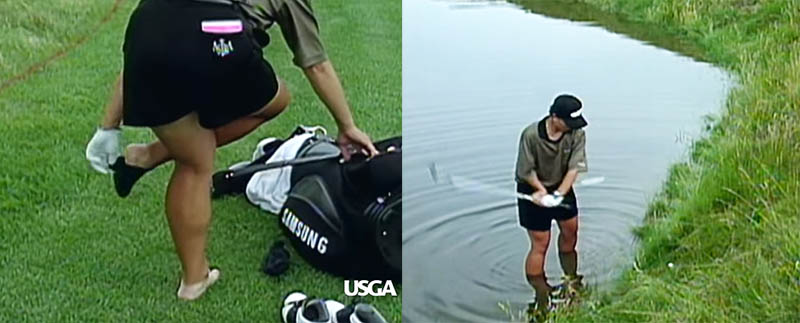
Se Ri Pak in the US Women’s Open playoff in July 1998.
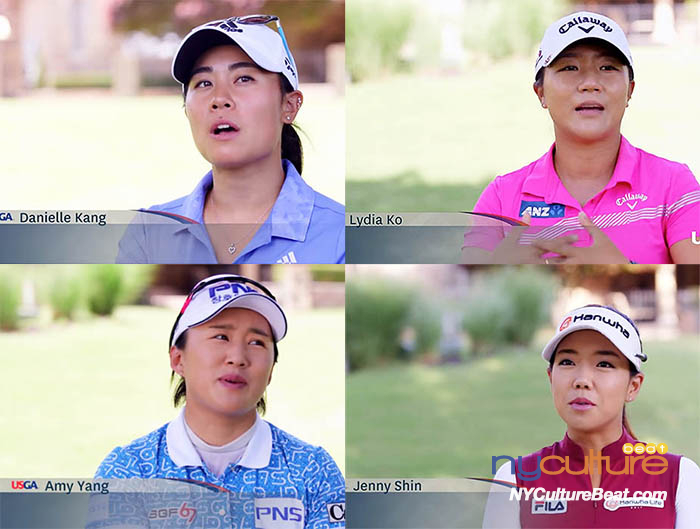 Se Ri’s Kids started playing golf with Se Ri Pak as their role model. Danielle Kang, Lydia Ko, Jenny Shin (Shin Ji-eun Shin), Amy Yang (Hee-Young Yang). Photo: USGA *Se Ri Pak: Inspiring a Generation, USGA <YouTube>
Se Ri’s Kids started playing golf with Se Ri Pak as their role model. Danielle Kang, Lydia Ko, Jenny Shin (Shin Ji-eun Shin), Amy Yang (Hee-Young Yang). Photo: USGA *Se Ri Pak: Inspiring a Generation, USGA <YouTube>
After Se Ri Pak pioneered as the first Korean LPGA champion in 1998, she opened the door to Mi-Hyun Kim, Grace Park (Ji Eun Park), and Hee Won Han, and numerous “Se Ri’s Kids” emerged. Dragon girls who were born during the 1988 (year of dragon) Seoul Olympics and watched Se Ri Pak and her “barefoot fighting spirit” around the age of 10 started picking up golf clubs. Inbee Park, Jiyai Shin, Na Yeon Choi, In-Kyung Kim, Angela Park, Seon-hwa Lee, Song-Hee Kim, Ji-young Oh, Sun-ju Ahn, Na-on Min, Ha-neul Kim, Bo-mee Lee, and Amy Yang (Hee-Young Yang) emerged as Se Ri’s Kids. Then, the next generation of Se Ri’s Kids have come out.
At the 2016 Rio de Janeiro Olympics, Se Ri Pak led the juniors to compete as coach of the women’s national golf team, and Inbee Park rewarded her mentor with her own gold medal after Inbee Park won at Rio. During the Rio Olympics, coach Pak showed off her leadership skills as the eldest sister by visiting the team’s rooms every day and personally cooking food such as army stew, soybean paste stew, and stir-fried pork.
Se Ri Pak was selected as the winner of the 2020 Bob Jones Award from the United States Golf Association (USGA). The Bob Jones Award, established in 1955, has been received by Arnold Palmer (1971), Jack Nicklaus (1975), Nancy Lopez (1998), Lorena Ochoa (2011), and Annika Sörenstam (2012).
#3 Golf Daddy & Good Daughter Complex
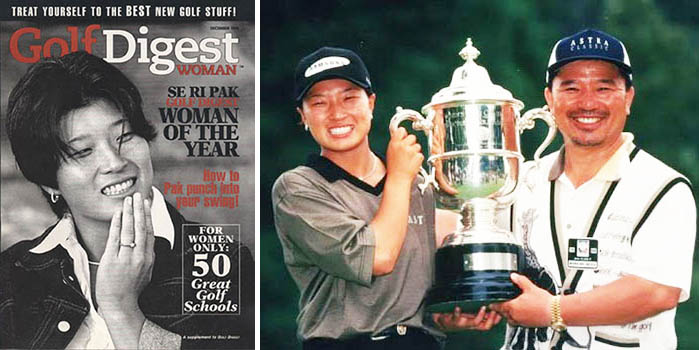
Se Ri Pak (left) on the cover of Golf Digest magazine. Se Ri Pak and her father, Joon Chul Pak, holding the 1998 U.S. Women’s Open championship trophy.
In the United States, there are “Tiger Moms” who raise their children harshly, and “Soccer Moms” who take their children to soccer practice and support them. In Korea, there are “Golf Daddys” who go all-in on golf for their children.
Behind Se Ri Pak’s success story, there was “Golf Dad” Joon Chul Pak. Inbee Park, Jiyai Shin, Mi-Hyun Kim, Na Yeon Choi, Birdie Kim (Ju-Yun Kim), Sung-hyun Park, Lydia Ko, Hyo-Joo Kim, Chella Choi (Woon-jung Choi), and Ha-na Jang also benefited from their fathers’ devoted support. A strong family bond is demonstrated as the fierce father and the entire family dedicate themselves to raising his daughter to become a professional athlete. The idea of loyalty and filial piety, a virtue of Confucian society, is also embedded. Athletes participate in competitions under the name of their parents and country.
The New York Times cited passionate parents as the hidden contributor to the success of Korean players in the LPGA. In July 1998, the New York Times said, “GOLF: Raised To Be A Champion; Father’s Firm Push Sent Pak To the Top of Women’s Golf,” paying attention to Mr. Joon Chul Pak’s tenacity.
At the time, golf was a game for the wealthy in Korea, with annual country club memberships costing between $200,000 and $1 million. Se Ri Pak’s family was not at that level. She participated in the Golf Digest Cup tournament held in Yeoju when Se Ri was in her second year of middle school in Daejeon. Joon Chul Pak went up to say hello to the teenage golfer’s parents who were gathered there.
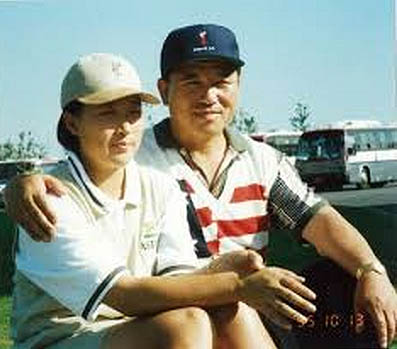
1996 Se Ri Pak and “Golf Daddy” Joon Chul Pak
Mr. Pak said in an interview with New York Times reporter Ira Berkow, “They completely ignored me. I guess my daughter and myself didn’t seem like much to them, because of their high social status. So I called Se Ri in front of the trophy and handed it to her, saying, ‘This is yours.’ The others looked at me as if I was some crazed lunatic. So I screamed back: ‘So what if I touch it! My Se Ri is going to take it home with her anyways!’ Se Ri nodded in agreement. Later, she did take the trophy back home with her.”
That trophy was not the only trophy that Se Ri Pak would win. She excelled in the amateurs and pros in Korea, and at the age of 20 (1998), her budding career saw her become a star on the world stage. As predicted when her father held her championship trophy when she was 14, it showed on the LPGA tour as soon as she joined in 1998. That year, Pak won four LPGA championships: McDonald’s LPGA, US Women’s Open, Giant Eagle LPGA, and Jamie Farr Kroger Classic.
The New York Times took note of Mr. Pak’s harsh Spartan education method. Her father scolded his teenage daughter severely when she did not follow golf instructions, and made her practice on Daejeon’s golf course every day before and after school, no matter the heat or extreme cold, and sometimes even had icicles in her hair while practicing. He said something happened. The father built up Se Ri’s courage by camping with his daughter in a tent next to the cemetery and leaving her alone in the dark. People at the golf course and in the neighborhood said that Joon Chul Pak was crazy, and his wife was also worried that he would kill her daughter. Because of a sport that is not very popular in Korea? However, Pak believed that her daughter would have the talent and perseverance to one day become a great player in the world. His faith became reality.
#4 Early education for aspiring golfers

Magazines featuring Michelle Wie (Sung-mi Wie), a Korean American golf prodigy from Hawaii, on the cover.
Tiger Woods played on the golf course at a young age thanks to his father, who was an amateur golfer. At the age of two, he competed in a putting contest against comedian Bob Hope on TV’s “The Mike Douglas Show,” and at the age of three, he was a golf prodigy who shot 48 in nine holes at the Navy Golf Course. Michelle Wie, a gifted girl from Hawaii, started picking up a golf club when she was 4, and by the time she was 10, she was competing in the U.S. Women’s Amateur Public Links Championship. In 2003, when she was 13, she competed in the Kraft Nabisco Championship (now ANA Inspiration) and the US Women’s Open.
Golf was once a noble sport in Korea. Ok-hee Ku and K. J. Choi (Choi Kyung-Ju) worked as caddies before becoming successful professional golfers. Se Ri Pak may be the first case of success through early education. The first time she picked up a golf club was in the 6th grade of elementary school, and in the 2nd grade of middle school, she began learning in earnest on the golf course. In elementary school, she was a track and field athlete, building her basic physical strength by competing in the shot put, broad jump, and 100-meter run, before going all-in on golf.
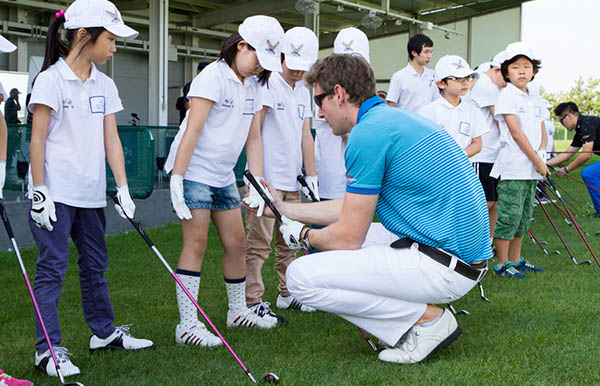
Photo: Callaway Golf https://www.callawaygolfkorea.co.kr
The earlier the education, the better. After Se Ri Pak’s sensation, there was a boom in early golf education in Korea. Numerous young Se Ri wannabes flocked to the golf driving range. Junior golf education costs a lot of money, including lesson fees, greens fees, competition participation fees, and field training fees. This is an investment made by golf dads who want to develop their children’s talents.
The more competitions the better. Se Ri Pak, Mi-Hyun Kim, and Hee-won Han developed their skills in student golf competitions. There are about 10 golf tournaments hosted by the Korea Middle and High School Golf Association (KJGA). It is important for golf prospects to gain as much experience as possible.
An early study abroad group also emerged. Grace Park moved to the United States in elementary school, Inbee Park went to study golf in middle school, and Lydia Ko went to New Zealand to study golf when she was 6 years old. This is also because it is advantageous to adapt to the local environment from a young age in order to participate in the LPGA.
Meanwhile, the KPLGA conducts youth programs, kids’ golf teams, golf driving range support, and golf clinics, and started the KLPGA Samchully Dream Tree Competition in 2015 to nurture girl golfers.
With the continued success of female golfers following Se Ri Pak, and golf being adopted as an official sport at the 2016 Rio Olympics, the number of junior golfers has increased rapidly, and the number of golf academies that serve as a gateway to becoming a professional has also mushroomed.
#5 Korean National Team: Elite Player Development System
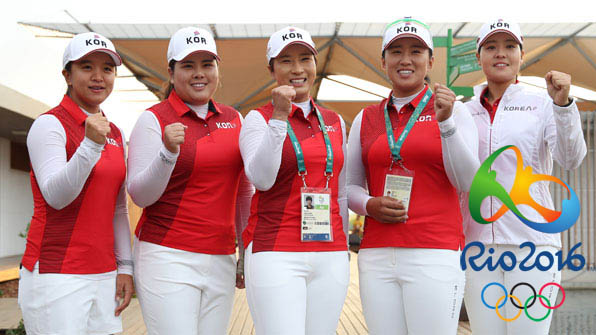
Coach Se Ri Pak (center), Sei-young Kim (from left), Inbee Park, Amy Yang, and In-gee Chun at the 2016 Rio de Janeiro Olympics, where golf was adopted as an official sport. Inbee Park won a gold medal at the 2016 Rio Olympics.
If junior players who received gifted golf educations in Korea want to become world-class professionals, it would be good for them to be selected for the national team. Excluding those who studied abroad, most of the first generation LPGA champions, including Se Ri Pak, Mi-Hyun Kim, Hee-won Han, and Soo-yun Kang, as well as Jiyai Shin, Na Yeon Choi, So Yeon Ryu, Hyo-joo Kim, Ha-na Jang, In-gee Chun, and Jin-young Ko, are members of the national team who played under the Taegeuk flag. To be selected for the national team, you must accumulate points by participating in junior competitions.
Before advancing to the world stage, they can accumulate a variety of practical experiences through Spartan-style training and high-level course competitions, including training camp for more than 150 days a year as national representatives. By representing your country, you will not only be relieved of the financial burden as a player, but will also be able to advance your career in international competitions. Therefore, gifted education, participation in competitions, and national representation are also a shortcut to the LPGA success. Because the United States does not have a national team system, golf can be financially unstable for many individual players.
#6 A Leap forward in the KLPGA
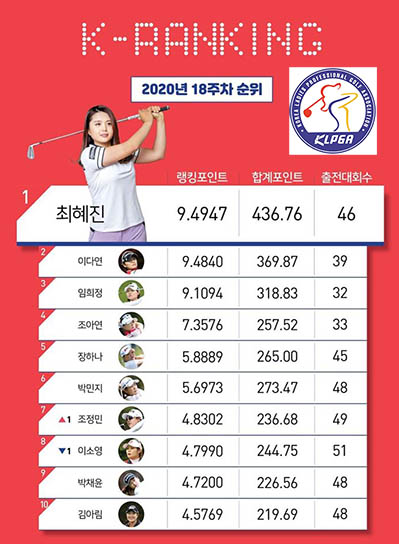
KLPGA player rankings (2020. 18th week)
Experience on the Korea Ladies Professional Golf Association (KLPGA) tour is also considered one of the secrets to success. In 2019 alone, 31 competitions were held on the KLPGA tour. Korean players build their skills and strengthen their competitiveness through the KLPGA tour. Before advancing to the LPGA or US Open, Korean golfers will have already experienced professional life in real life. Although she may be a rookie in American competitions, she has experience as a champion in the KLPGA.
The KLPGA Tour has emerged as a global tour along with the LPGA of the United States and the JLPGA of Japan. The KLPGA had a humble beginning. It originated in 1978 at the Royal Golf Course in Yangju, Gyeonggi-do (currently Lakewood Golf Course), with the first women’s professional golf professional test, in which eight people, including Kang Chunja, Han Myeonghyun, Ok-hee Ku, and Ahn Jonghyun, participated. The first KLPGA tour was held in 1988, when the sports boom was at its peak due to the Seoul Olympics, and the late Koo Ok-hee won the LPGA/Standard Register Classic, creating a legend in women’s golf. https://www.klpga.co.kr
With the international success of star golfer Pak Se Ri in 1998, the KLPGA tour also experienced rapid growth. The competition also expanded to China and Vietnam. Under the influence of Pak, dreamy girls grew up quickly.
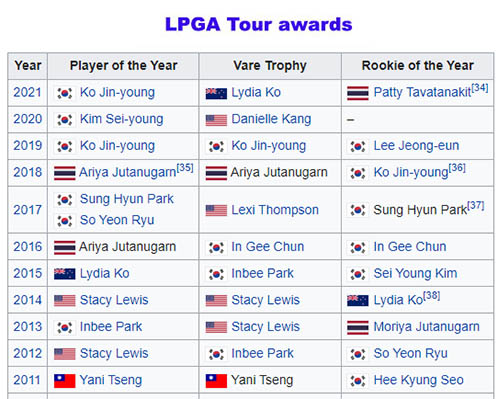
Wikipedia https://en.wikipedia.org/wiki/LPGA
#7 Corporate sponsorship and turning your life around

Synergy effect between Korean female golfers and companies. Se Ri Pak’s sponsors changed to Samsung, CJ, KDB Group, and Hana Bank.
SportsBusiness wrote in a March 2020 article titled “The dominance of Korean women’s golf is a positive force for Asia and the world” that sponsorship from large Korean companies has supported the success of Korean female golfers. In the past, the prize money for winning golf tournaments was small, but with large corporations stepping in as sponsors, the prize money has increased significantly. Additionally, international companies interested in the Asian market are also likely to show interest in sponsorship. Sponsoring companies line up for outstanding players, and each golf tournament has a sponsoring company. LPGA commissioner Mike Whan noted that overseas business opportunities have expanded due to the success of Asian players, and that LPGA tour viewership is high in Korea and Japan.
In professional sports, prize money and sponsoring companies are the criteria for success. In 1996, Se Ri Pak signed an incentive contract with Samsung for 10 years, and in 2002, she transferred to CJ. Se Ri’s Kids vividly witnessed that, instead of dreaming of attending a top university and becoming a celebrity, they could achieve wealth and fame through golf.
With Pak's success, competition among companies to scout female professional golfers has intensified. The average annual sponsorship fee is set at 100 million ($74,000) to 1.5 billion won ($1,10 million), depending on season performance, star quality, and potential. As for incentives, it is known that if you win separately, you will receive 50-80% of the prize money. The requirement is to participate in more than 20 competitions per year.
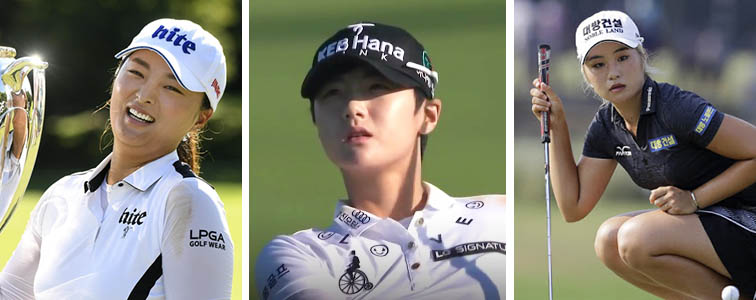
Jin-young Ko, Sung-hyun Park, Jeong-eun Lee6.
As a business, golf marketing is a bonanza. This is because golf players are “walking billboards.” Marketing costs for the golf industry, which can increase brand awareness, improve corporate image, and target VIPs, are increasing day by day. This is the so-called heyday of golf marketing. In particular, the LPGA Tour is the best opportunity for companies to market their brands globally. The reason why luxury brands such as Rolex, Omega, Mercedes-Benz, and Volvo focus on golf marketing is because they target the high-income class.
Korean companies are engaging in marketing activities ranging from sponsoring golf players to providing golf supplies and hosting golf tournaments. Recently, companies have gone beyond player sponsorship and are accelerating expansion into overseas markets as an official partner of the LPGA Tour. Construction companies have established golf clubs, and financial institutions are holding golf meetings for VIP customers and providing lessons to star golfers. Due to this synergy effect, the close relationship between female golfers and large corporations is expected to continue.
Korea's golf boom owes a debt to the Korean golf craze sparked by Se Ri Pak and the Se Ri Kids. The "Queens of the Green" and "Golf Goddesses" are expected to lead the golden age of K-Golf for a while.
Rolex World Female Golfer Rankings (as of March 6, 2023)
Rank/ Country/ Player / Average Points / Total Points
1. NZL 리디아 고 LYDIA KO 8.59/ 386.55
2. USA NELLY KORDA 8.10 / 283.56
3. KOR 고진영 JIN YOUNG KO 7/38/ 265.68
4. THA ATTHAYA THITIKUL 5.95/ 285.61
5. AUS 이민지 MINJEE LEE 5.84/ 268.86
6. USA LEXI THOMPSON 5.73/ 211.94
7. CAN BROOKE M. HENDERSON 5.43/ 249.93
8. KOR 전인지 IN GEE CHUN 4.69/ 201.86
9. KOR 김효주 HYO-JOO KIM 4.43/ 190.56
10. JPN NASA HATAOKA 4.12/ 202.10
https://www.rolexrankings.com/rankings
Sukie Park
A native Korean, Sukie Park studied journalism and film & theater in Seoul. She worked as a reporter with several Korean pop, cinema, photography and video magazines, as a writer at Korean radio (KBS-2FM 영화음악실) and television (MBC-TV 출발 비디오 여행) stations, and as a copywriter at a video company(대우 비디오). Since she moved to New York City, Sukie covered culture and travel for The Korea Daily of New York(뉴욕중앙일보) as a journalist. In 2012 she founded www.NYCultureBeat.com, a Korean language website about cultural events, food, wine, shopping, sightseeing, travel and people. She is also the author of the book recently-published in Korea, "한류를 이해하는 33가지 코드: 방탄소년단(BTS), '기생충' 그리고 '오징어 게임'을 넘어서 (33 Keys to Decoding the Korean Wave: Beyond BTS, Parasite, and Squid Game)."
- 한류를이해하는33가지코드,
- 여자골프,
- 박세리,
- 박인비,
- 성공비결,





